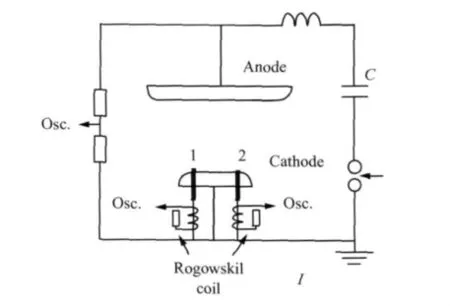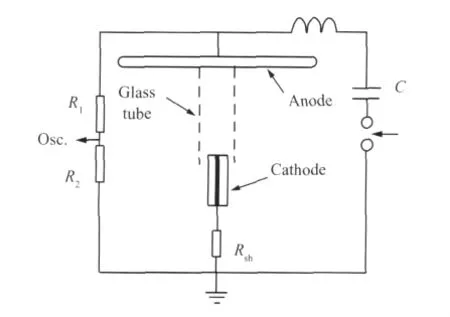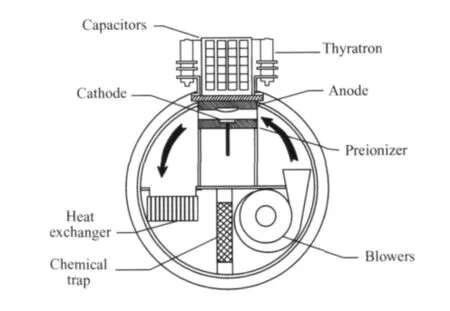非链式脉冲DF激光器的关键技术
2011-11-06张来明谢冀江潘其坤
阮 鹏,张来明,谢冀江,潘其坤,骆 聪
(1.中国科学院长春光学精密机械与物理研究所激光与物质相互作用国家重点实验室,吉林长春130033; 2.中国科学院研究生院,北京100049)
1 Introduction
Deuterium fluoride(DF)lasers have been under development since about 1970.The spectral regions of DF laser are from 3.5 μm to 4.1 μm,which is a good atmospheric transmission window as well as the absorption band of air pollutants(hydrocarbons,sulfur dioxide,nitrogen oxides,etc.).Its intrinsic ability to store high levels of energy makes this type of laser attractive to the researcher for producing high power levels for an air and missile defense weapon system.Besides,it can be used in laser radar transmitters,infrared fiber-optic communications and atmospheric detecting.
Pulsed DF chemical lasers based on the electrical dissociation of SF6are very attractive because they used gases easy to handle,while they are not corrosive and unlike F2and F2mixtures there is no risk of premature ignition[1].The chain DF laser is driven by burning the gas mixture in combustor,and is comprised of a combustor,a nozzle bank,optics,a diffuser and a ejector.The chain DF laser uses F2as the oxidizer so it has the explosion possibility when F2reacts with D2or deuterocarbons.Compared with the chain DF laser,there is no risk of corrosion and explosion,and the structure is compact and easy to handle.For all these advantages,the non-chain DF laser becomes an attractive research object.However,the DF laser is different from other gas lasers or chemical lasers for its distinctive discharge characteristics and working mechanism.Electric discharged non-chain DF laser usually uses mixtures of F atoms(contained in SF6)and D atoms(from deuterocarbons)as active media.The discharge is used to cause chemical reactions in order to achieve population inversion and then generate laser.Relative to other gases that can form stable negative ions by attaching electrons,SF6is a strongly electronegative gas.Its strong electro negativity makes SF6molecule dissociation very hard,so it is important to choose a suitable type of discharge.The uniformity of discharge should be concerned for it is one of the key factors to decide whether we can obtain laser output.
Mixture ratio technology is also very important.D atoms are from deuterocarbons, such as D2,C6D12and C2D6.For choosing different deuterium donors,the expense and laser output will be different.
The by-products and heat generated during the chemical reaction and discharge process would reduce the laser quality,such as output powers,energy and pulse widths,so the recirculating and cooling technology seems important also.
The following section describes the key technologies in more details.
2 Self-initiated volume discharge
The strong electron attachment of SF6makes the establishment and maintenance of electrical discharge difficult in SF6containing gas mixture[2].Various types of discharges have been developed to overcome these drawbacks.Recently,it was shown that in strongly electronegative gas especially in sustaining a non-chain reaction DF lasers,the self-initiated volume discharge presents a decisive advantage over the conventional ones and moreover is very simple to use[3-5].
Strongly electronegative gases,such as SF6and F2are distinguished by(1)high values of their operating reduced electric fieldsE/Nand(2)high magnitudes of electro negativity χαdefined as the negative ion to electron concentration ratio[2].These give rise to some special features of the discharge displays.To briefly summarize,they are as follows.First,SF6molecule dissociation by electron impact becomes important.Dissociative ionization and electron attachment processes characteristic of SF6can significantly contribute to the gas decomposition,specifically to F-atom production[6].Second,high positive ion concentrations along with that the relation electro negativity equal to electron attachment rate η holds under the working conditions lead to the dissociative electron-ion recombination can strongly influence the SF6discharge plasma parameters both qualitatively and quantitatively.Third,it is found that SF6molecules decomposition,either through electron impact immediately or by the dissociative ionization and electron attachment greatly influence the discharge characteristics,specifically its voltage and current waveforms.Professor Apollonov presented this new discharge technology,self initiated volume discharge,directed to the special characteristics of SF6molecules,and the following factors should be considered in order to achieve self initiated volume discharge.
(1)a cathode should posses a small-scale(10 ~ 50 μm)surface roughness;(2)to match a circuit wave impedance to the discharge plasma resistance at a given interelectrode distance,a mixture pressure should be chosen in such a way that the discharge burning voltage determined by the conditions of the gap breakdown in SF6[7]should be two times less than the voltage fed to the gap;(3)increasing electric energy through increase in the generator's capacitance at a given maximum generator,voltage should be followed by growth of the discharge volumeVasV∶C3/2,whereCis the generators'capacitance[8,9].On fulfillment of all these conditions,one should also try to maximally decrease the period of time during which the energy is deposited in the discharge plasma.
The electrode structures used by Apollonov in self-initiated volume discharge are shown in Figs.1,2,3.
The interelectrode distance in Fig.1 is 4 cm.As the electrodes there were a copper stripe of 0.5 mm thick and 16 cm long(cathode)stood edgewise and a disk anode with the diameter of 6 cm rounded off along its perimeter to a radius of 1 cm.The breakdown was force initiated at the gap edge by a low-current spark restricted by resistanceR=900 Ω.

Fig.1 Knife-edge gap geometry

Fig.2 Plane-plane gap geometry
The SIVD dynamics was also studied in the plane-plane gap geometry in experiments with a sectioned cathode diagrammatically depicted in Fig.2.In this case,the interelectrode distance was the same as Fig.1,however as a cathode there was a 2 mm flat disk rounded off along its perimeter to a radius of 1 cm.Isolated conductors of 1 mm in diameter were inserted into holes with the diameter of 2 mm drilled within the flat part of the cathode and spaced by a distance of 4 cm.The basic cathode and these conductors were connected to a common bus.The current through each the conductor was recorded by Rogowskii coils.One of the conductors 1 extended 1 mm above the cathode surface which ensured a primary gap breakdown just at this point whilst comparison of oscillograms of currents through the initial 1 and control 2 conductors allowed the SIVD extension over the gap to be followed.
Fig.3 shows a rod(cathode)-plane geometry and interelectrode distanced=4 cm.The end of a 1.5 mm diameter rod dressed with polyethylene insulation was used as a cathode and the anode was a disk of diameter 10 cm[2].

Fig.3 Rod-plane geometry
They used this discharge technology to achieve more than 300 J laser energy output,and it is the highest energy output till now.
3 Mixture ratio technology
The active mediums are F and D atoms,and D atoms are from deuterocarbons,such as D2,C2D6and,C6D12,while F atoms are from molecules containing F atoms such as F2and SF6.Note that choosing different donors of F atoms and D atoms will cause different output parameters of DF lasers,which concludes laser energy,electrical efficiency,output power and so on.At the same time,different donors of F and D atoms need different discharge conditions(like current,voltage,pressure,etc).So the expense will be different too.Therefore,it is important to choose suitable donors of F and D atoms.Simultaneously,after choosing the suitable donors,the ratio of the two molecules of mixtures is worth considering.Because the ratio of the mixture decide whether we can obtain laser outputs and if there has laser output,the ratio of the mixture affects the output laser quality.With the analyses above,we can conclude the following factors:(1)in order to choose the donors of F and D atoms,we should analyze the characteristics of the molecules;(2)before the experiment,it is important to read relative papers about DF lasers and then to do experiments according to the ratio of the mixture in the reference papers.
Now we compare the difference between F2and SF6.Firstly,F2is the highest electro negativity molecule,so its ionization energy is higher than those of SF6molecules and the cost will be higher.Secondly,F2has high oxidbillity and toxicity,and can react with all the elements other than inert gas and nitrogen.But,SF6is one of the best materials to have good chemical stability and its inertia is similar to nitrogen and it is unit-poisonous.Thirdly,F2can cause chain reaction with deuterium compounds and have the risk of explosion,while SF6can make non chain reaction with deuterium compounds and be easy to control.HF and DF pulsed chemical lasers based on the electrical dissociation of SF6are very attractive because the gases they used are not corrosive,easy to handle and unlike F2+H2mixtures,and there is no risk of premature ignition.
The donor of F atoms is chosen,and then we need to consider the donor of D atoms.The experiments made by H.BRUNET in France showed that compared to the HF energy of 10 J obtained with C2H6as hydrogen donor for the same experimental conditions the output energy previously achieved with D2was low,less than 3 J per pulse[10].Two main reasons can explain this behavior.The first one is related to the kinetics of the pumping reaction and the other to the discharge stability.And the experiments showed that the electric discharge stability is increased by adding C2H6to the SF6gas mixture.Unfortunately,it was not possible to employ C2D6because of the excessive cost of this deuterium compounds.Therefore they made a search for a not too expensive deuterium hydrocarbon and they found that C6D12could be an interesting product.Then they first tested C6H12as a hydrogen donor instead of C2H6,and very good results were obtained on HF emission since the drop off in output energy was only about 5%.Consequently,C6D12was ordered and tested and the laser energy was higher than that achieved with D2.Therefore considering all the factors we can conclude that C6D12is the best choice for donor of D atoms in the same experiment conditions.
4 Recirculating and cooling technology
The heat generated in the chemical reaction,the byproducts caused by the non chain reaction along with D2,DF and other elements which could affect the output laser quality also should be considered.So it is very significant to have a gas recirculator loop to cool and process the gas mixture.In the following sections,we will discuss the different solutions direct to different problems.
Firstly,we choose the heat exchanger to cool the working gas.The heat exchanger is made of chillers;the water is constantly circulating in the chillers so as to bring the excess heat away.This system can make the temperature floating around in the 2℃.
Secondly,the cleaning of the discharge region of discharge products between pulses is especially important in DF chemical lasers because residual DF molecules would degrade laser outputs,so we choose axial-flow fan as a recirculating system.This axial flow fan has advantages as follows:high speed,small size and easy to integrate with the flow system.The recirculating system has two axial-flow fans,and the flow velocity of 80 m/s can realize 3 to 5 cleaning factors.H.BRUNET in France used two fans to realize a flow velocity of at least 4 m/s in the discharge region.This flow velocity is necessary to achieve an equivalent of even one full gas exchange between pulses at a repetition frequency of 100 Hz in his experiment.
Thirdly,the probable deleterious contaminants in the gas mixture like DF and SnFm-type species also would degrade laser outputs[1].In order to solve this problem,we can use the chemical trap.The trap is a rectangular box placed inside the laser system.The molecular sieves are put in the rectangular box to remove deleterious contaminants.Direct to the characteristics of working medium,we choose 5 A and 13 X molecular sieves.Fig.4 is the laser system used by H.BRUNET[11].

Fig.4 Cross sectional drawing of laser system
5 Conclusions
Three key technologies about DF lasers have been discussed in this paper,which includes self-initiated volume discharge,mixture ratio,recirculating and cooling technologies.DF laser based on self-initiated volume discharge can obtain the highest output energy and power(the monopulse energy of DF laser is 330 J),so this discharge method is a effective way of chemical reaction sustain in working mixtures of non-chain DF laser.The structure of electrode is the decisive factor of self-initiated volume discharge.Mixture ratio technology,recirculating and cooling technology are important to develop all kinds of gas and chemical lasers.
Besides,there are othertechnologiesthat haven't been discussed in this paper,such as large volume uniformity discharge,efficiency improving technology,coating technology and so on.All the elements that may affect the laser output performance should be considered when a DF laser is developed.
Reference:
[1]BRUNET H,MABRU M,VANNIER C.Repetitively-pulsed HF chemical laser with high average power[J].SPIE,1992,1810:1275.
[2]APOLLONOV V V,BELEVLSEV A A,FIRSOV K N,et al..High-power pulse and pulse-periodic non-chain HF(DF)lasers[J].SPIE,2002,4747:31-43.
[3]APOLLONOV V V,BELEVLSEV A A,FIRSOV K N,et al..Advanced studies on powerful wide-aperture non-chain HF(DF)lasers with a self-sustained volume discharge to initiate chemical reaction[J].SPIE,2003,5120:529-541.
[4]APOLLONOV V V,BELEVLSEV A A,KAZANTSEV S Yu,et al..Self-initiated volume discharge in non-chain HF lasers based on SF6-hydrocarbon mixtures[J].Quantum Electronics,2000,30(3):207-214.
[5]APOLLONOV V V,BELEVLSEV A A,KAZANTSEV S Yu,et al..Development of a self-initiated volume discharge in nonchain HF lasers[J].Quantum Electronics,2002,32(2):95-100.
[6]NAKANO N,SHIMURA N,PETROVIC Z L.Simulation of RF glow discharges in SF6by the relaxation continum model:physical structure and function of the narrow-gap reactive-ionetcher[J].Phys.Rev.E,1994,49:4455-4465.
[7]APOLLONOV V V,FIRSOV K N,KAZANTSEV S Yu,et al..Discharge characteristics of a non-chain HF(DF)laser[J].Quantum Electron,2000,30(6):483-485.
[8]APOLLONOV V V,BELEVLSEV A A,FIRSOV K N,et al..Self-initiated volume discharge in mixtures of SF6with hydrocarbons to excite non-chain HF lasers[J].SPIE,2000,4071:31-43.
[9]APOLLONOV V V,FIRSOV K N,KAZANTSEV S Yu,et al..Scaling up of non-chain HF(DF)laser initiated by self-sustained volume discharge[J].SPIE,2000,3886:370-381.
[10]BRUNET H.Improved DF performance of a repetitively pulsed HF/DF laser using a denudated compound[J].SPIE,3092:494-497.
[11]BRUNET H,MABRU M,VANNIER C.Repetitively-pulsed HF chemical laser with high average power[J].SPIE,1992,1810:273-276.
